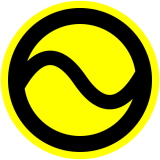Interlingue Symbol

The language Interlingue, known as Occidental until 1949, is a planned international auxiliary language created by Edgar de Wahl, a Balto-German naval officer and teacher from Tallinn, Estonia, and published in 1922.
The symbol of Occidental was chosen in 1936 after some deliberation and many other proposed symbols, including stylized letters, a star as in Esperanto and Ido, a setting sun to represent the sun in the west (the Occident), a globe, and more. The tilde, already used by the Occidental-Union, was eventually selected based on five criteria: symbolic character, simplicity, originality, inconfusability, and for being bichromatic (having two colours) as opposed to polychromatic. Beyond the five criteria, the Occidentalists at the time referenced the lack of a fixed meaning for the tilde in the public sphere, and its similarity to a waveform, implying speech.
© Symbols.com
